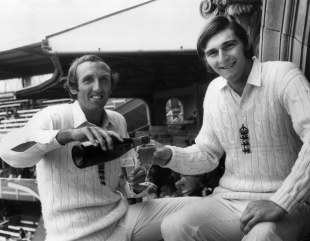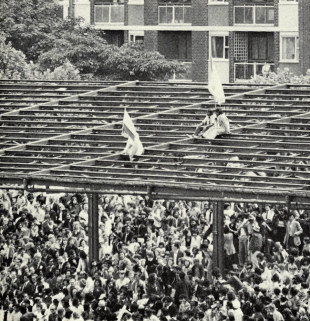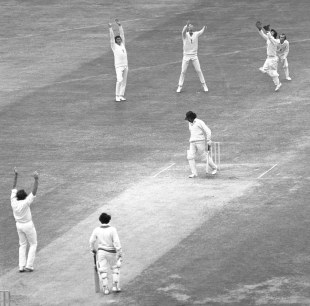At Lord's in 1974, India were bowled out in a little over an hour for 42, in a series which started full of promise but soon fell apart
When England and India start their four-match series next week, the clash between two of the leading sides in Test cricket is eagerly anticipated. A genuinely appealing contest is ahead of us, and not one artificially pumped up by media hype, which surrounds even the most mundane of tours there days.
Back in 1974, the English media adopted a low-key, almost comatose, approach to anything other than Ashes summers, but despite that India were an intriguing proposition and many predicted a close series.
India arrived in a bitterly cold England in April as the leading side in the world. In the previous three years they had won series in the Caribbean and England, and then defeated England at home. Their superb quartet of spinners (Bishan Bedi, Chandrasekhar, Prasanna and Venkat) backed by some top batsmen (Sunil Gavaskar, Ajit Wadekar, Gundappa Viswanath) made them a formidable team, albeit one lacking any real seam prowess. West Indies and Australia were rebuilding, while England, on the back of a drawn series in the West Indies the previous winter, were considered by many to be running India a close second.
Ten of India's 12 three-day warm-up matches were drawn, largely because of what Wisden described as "outrageously unkind" cold, wet weather, which was a hallmark of the summer. Only in the last two games, against Essex and Surrey, did the tourists win, and unexpectedly it was seam bowler Abid Ali who did much of the damage on both occasions.
In the first Test, at a damp and chilly Old Trafford, India lost by 113 runs. The total attendance of 19,700 over the five days was the lowest recorded in England for a five-day Test. India's performance was lacklustre, and their spinners failed to cope with alien conditions.
They won the two tour matches ahead of the second Test at Lord's, although Imran Khan caused them more than a few problems by making 160 for Cambridge and Oxford Universities.

| |||
All the talk in the build-up to the game centred on the England selectors' decision to drop an out-of-form Geoff Boycott in favour of David Lloyd. It was the start of three years of largely self-imposed international exile for Boycott.
At Lord's, finally the sun came out, but on the plumbest of pitches England made hay after winning the toss and piled up 629 with hundreds from Dennis Amiss, Tony Greig and captain Mike Denness. It could have been worse for India - at one stage on the second afternoon England had been 571 for 4.
India's three-pronged spin attack - Venkat was the one to miss out - was mauled. Bedi became only the third bowler to concede 200 runs in an innings in a Test in England, finishing with 6 for 226, while the overall figures for the trio were 8 for 425. Bhagwat Chandrasekhar only bowled 10 overs after damaging a finger. Wadekar was questioned in the press for his reluctance to use Abid Ali, and for almost blanking Eknath Solkar, who bowled six overs with the new ball on the first morning and was not called upon again.
When India replied, they cruised to 131 for 0 - Gavaskar and Farokh Engineer batting without a care in the world in front of a sun-drenched crowd on the Saturday morning. The small Ladbrokes tent at the Nursery End offered 6-4 for the draw, and few believed there would be any other result.
Although Gavaskar fell shortly before lunch, there was no cause for alarm in the Indian camp. And yet, from then on wickets fell regularly, largely because of poor shot selection and a strategy of playing shots rather than settling down to play for the draw. "There was something reckless about the way several got out," wrote John Woodcock in the Cricketer. "I am all for adventure by that has to be tempered by judgement." India were bowled out minutes before the close for 302 - a deficit of 327 - and asked to follow on, ended on 2 for 0.
With the pitch remaining true, the fourth day, which was after a rest day on Sunday, was expected to be another one that favoured the batsmen. However, the Monday morning was overcast and humid, offering markedly different conditions to those on the first three days, and in front of a small crowd England's seam pairing of Chris Old and Geoff Arnold wreaked havoc, skittling India for 42.

| |||
"The ball didn't do as much in the air as everybody thought, but it certainly went off the pitch," said Arnold, who started the rout with 4 for 8 in his first four overs. "Obviously what happened was that it had sweated under the covers overnight and greened up just enough to give the ball the sort of purchase I needed. It was amazing really. Just one of those days." He was not even in the original starting XI, only coming in when Bob Willis pulled out on the eve of the game with a strained back.
In the second over Engineer, who had top-scored with 86 in the first innings, perished leg-before to a straight one from Arnold, who had put doubt in his mind with an awayswinger followed by an inswinger before the ball that held its line.
An over later India were 5 for 2 when Wadekar was completely cleaned up by Old, and soon after, Arnold dismissed Viswanath courtesy of a low catch in front of first slip by Alan Knott.
While several batsmen perished to poor strokes, Brijesh Patel, in superb form in the county matches but cruelly exposed against the moving ball in the Tests, was undone by a snorter from Arnold that moved away and lifted; Knott took his second catch to leave India 14 for 4.
While Gavaskar remained, the previously noisy Indian contingent in the Mound Stand had hope, but he was trapped back in his crease by an Arnold inswinger to leave India 25 for 5, and after that it was a procession.
Old, operating from the Nursery End with a slight breeze behind him, polished off the innings by bowling Prasanna and Bedi with successive deliveries, but was deprived of a hat-trick opportunity when Chandrasekhar, still nursing an injured thumb, opted not to bat. In 65 minutes and 15 overs, India had lost nine wickets for 40. Old, who finished with a Test-best 5 for 21, ended with a burst of 4 for 6 in 17 balls.
Solkar was left marooned on 18 not out, his innings including a bouncer on the head from Old and then a hooked six the next delivery, when the bowler dug in another one.
As Arnold and Old posed on the pavilion balcony for press photos, Wadekar did not even allow his players time to sit down and change, forcing them back to the Nursery End for a long net session. When he finally faced the journalists, he admitted, "we have fallen a long way today before some fine seam bowling".
"On Sunday I thought we were only halfway through this fight," admitted Denness. "I certainly never expected anything like this."

| |||
Gavaskar said it was simply that "Arnold and Old bowled five good balls which got our five top batsman out... after that there was no resistance from the tailenders."
Jack Bailey, the MCC secretary, was left facing angry spectators, who had paid for a full day. "We are always sorry when a match finishes early," he told the Daily Express, but he dismissed suggestions the teams should have played a beer match. "We tried it some years ago and it was found the cricket was so anti-climactic that neither the crowd or spectators found it entertaining."
"To Indians in India this might seem like the end of the golden age," Woodcock wrote in the Times. "Having become accustomed to success, they will not have cared to hear India had been bowled out for the lowest score they had ever made and the lowest ever to be made in a Lord's Test."
In the Cricketer, former England captain Tony Lewis said India's problems "might have been technical in conditions which favoured movement off the pitch, but the psychological test of replying to a total of 629 surely underlay their difficulties. In that case everything must go right. All the clichés of a dressing room must be realised - or else the trough is deep and pitch dark. India fell headlong down the familiar slope of despondency."
But Wisden pulled few punches. "Basically, [India's] batting was not much weaker than in 1971… but collectively [it] was too weak and brittle to be able to hold its own at international level. As captain, Wadekar had obviously used up all his luck in building up his hitherto unbeaten record."
What happened next?
- England routed India in the final Test, at Edgbaston, scoring 459 for 2 and bowling India for 165 and 216 to win the match by an innings and 67 runs, and in so doing completing a 3-0 series whitewash
- England, buoyed by this and a hard-fought drawn series against Pakistan, headed to Australia with media expectations they would be able to defend the Ashes. They were crushed 4-1 and blown away by the pace of Dennis Lillee and Jeff Thomson
- Wadekar was sacked as captain and retired soon after, while Denness was fired after losing the first Test of the following summer to Australia
Is there an incident from the past you would like to know more about? Email us with your comments and suggestions.


No comments:
Post a Comment